
The contestants have 5 minutes to build their science lessons.
NSTA Convention 2003
Linda Shore, hostess of Iron Science Teacher, is a brilliant woman. When we were invited to present an Iron Science Teacher competition at the NSTA convention in 2003, she agreed to do it, and then proceeded to pick a secret ingredient that was perfect. Everyone attending the convention possessed the secret ingredient, no one outside the convention did. This was to be battle Convention Guidebooks.
She then proceeded to find excellent contestants: She invited Arthur Eisenkraft, a former president of NSTA, plus Grand Master Hank, a local science teacher who did television programs for kids after school which used Rap music to illustrate science, Modesto Tamez, Tory Brady, and I filled out the team. (Don Rathjen was invited but could not come at the last minute without Don the rest of us had a chance to win.)
People began to show up an hour before the program, this promised to be an interesting evening. By showtime, every seat in the huge auditorium was full. We were going to do Iron Science Teacher in front of our largest audience ever.
Linda began by telling the history of iron science teacher using a powerpoint presentation. People laughed at some of the previous topics: fruitcake, hot dogs and feminine hygiene products. They also laughed at the truth behind one of the goals of Iron Science Teacher, "to provide teachers with ideas about how to teach multimillion dollar state and national science teaching standards using, trash, recyclables, and inexpensive materials." Then she got to the real reason, "to allow teachers to receive applause for great teaching."
Linda started the theme music and the show was on.
We were introduced, the secret ingredient was revealed, and then we went to tables to construct our lessons.

While we were building, Linda went out into the audience to ask them to contribute their ideas for lessons using the NSTA Convention Books. The audience particularly liked the idea of a spitwad shooter which came from a student.
We went alphabetically:
Tory rolled the cover into a tube, then made the pages into a wad which she blew out of the tube. A spitwad shooter! She did a great job extracting science from the shooter. She placed the wad at the far end of the tube from her lips and blew. It only went a little way, then she placed it closer to her lips and it went further. She pointed out that the work done on the wad was force times distance, and that over the longer distance of travel in the tube the air pressure from her lungs did more work on the wad, giving it more kinetic energy, so more speed and more range. She then asked the audience what a longer tube would do? they answered correctly that a longer tube would make the wad go further still, the experiment was done and voile' they audience was right. Tory finished to applause.
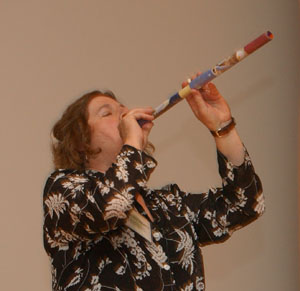
Then it was my turn. I said that in order to think up an idea for a science lesson I needed music. So I made a straw oboe and gave the audience instructions on how to make one, Straw oboe Instructions. I played the oboe.
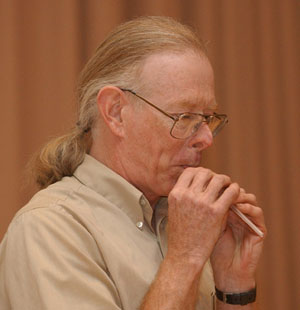
Then said I realized that sound was trapped inside the oboe and that I might be able to use the cover of the NSTA book to make a cone which I could use to make a bell for my oboe like the bell on a trumpet. The bell on a musical instrument allows more of the sound trapped inside the instrument to emerge making the instrument louder. I said that they might not know that sound was trapped bouncing back and forth inside a straw oboe but that it was, so that if I cut the straw oboe while playing it, then shorter and shorter wavelength sound waves would be trapped in the straw, so higher and higher pitches would come out. I did that and indeed the pitch rose as the straw was cut short.
Then I did a slight aside and said perhaps people didn't know how sound bounced off an open end of a tube. I said here's a model and used a bottle brush inside the rolled up cover of the NSTA book.
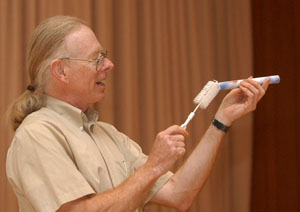

When the brush exits the tube its bristles spring
outward.
When the brush exited the end of the tube the bristles sprang outward. That's what the compressed air in a sound wave does. But air is more elastic than bristles, so I employed a larger PVC tube with a lead weight at one end tied to a long spring of rubber bands. When the lead weight came out the end of the tube, it stretched the rubber bands overshooting its equilibrium position, just as air does. The compression overshoots just like the lead weight and pulls a partial vacuum at the end of the tube which goes back down the tube as an expansion. That's how sound bounces back and forth inside a tube. However the cone lets the compressed air gradually expand so that it doesn't overshoot as much and so doesn't bounce back as much, thus allowing more sound to exit the tube.
I took out the straw oboe with the bell attached and played it, it filled the hall with sound. You see I said, the sound does get out and it is louder.
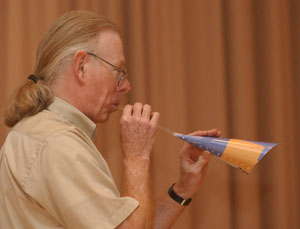
I also noted that the bell directed the sound in the forward direction. So I spun around so they could hear the directional nature of the sound from a straw oboe with and without the bell. After I spun around I said that was my rendition of the Flight of the Bumblebee. They laughed.
Next I said that one rule of teaching was that every success was to be followed by excess, so I brought out my bigger horn. This one was made from 4 covers and so the opening was 4 times the area of the first horn. I played it and it was louder still.
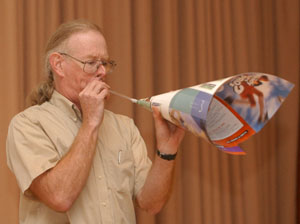
Now I said that I remembered how things should really be done, I remembered the story of Goldilocks and the three bears. there should always be three horns, one too small, I held up the single cover horn, one just right, I held up the 4 cover horn and one ... I paused to let the audience answer 'TOO BIG." They laughed as I went behind the construction table and pulled out a huge horn made from 16 covers. They laughed as I played it.
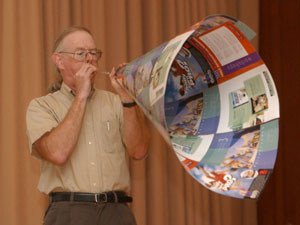
I concluded by pointing out that I finally realized that I had created an "open ended activity" Pointing at the huge flared end of the horn, A really open ended activity.
I got great applause.
Grand Master Hank went next and brought up audience members to keep the beat while he put the words of the book into a rap song. At first the team couldn't keep the beat but with his coaching they got it. He also got the audience to sing along to the chorus. He really knew how to engage an audience. I wish I'd have thought of bringing up audience members.
He got cheers from his hometown crowd.
Arthur weighed a convention book then found the force necessary to pull it thus measuring its friction coefficient on a wood plank. He then measured the friction coefficient a second way by making an inclined plane and finding the lowest angle at which the book slid down the plane. He had a slide that showed a Nike shoe sliding down the plane with the logo "Just mu it" (mu is the standard symbol for the friction coefficient.)
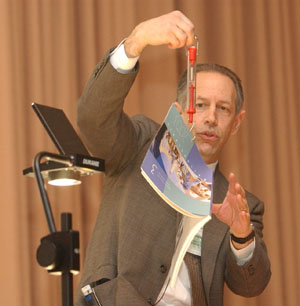
Then he said he could teach all of physics with the book. He started with Newtons laws: An object at rest stays at rest, dead easy. An object in motion stays in motion, he threw a book. Action and reaction. He held up a book and pointed out his force on it and its force on him.
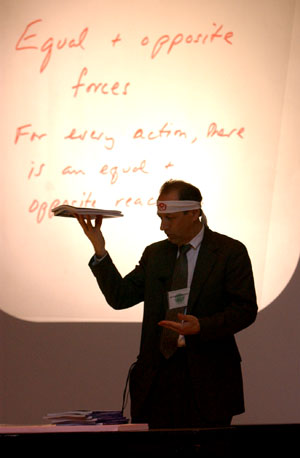
Then he turned to Linda and said give me any concept and I'll teach it: she said temperature and he pulled a hidden book out of his shirt. This book is warm, the ones on the table are cold. The audience laughed at that.
Linda said magnetism, he attached N and S labels to the covers of two books and used them to show repulsion and attraction.
And so on through all of physics.
He got great applause.
Last but never least, Modesto came on stage.
He praised Faraday and in honor of Faraday Modesto unwound a piece of braided electric wire from a lamp to get a small thread of coper wire. He then connected the wire thread to a D-cell battery and held it near a magnet. The first few times he tried nothing happened, but at last, to the relief of the audience, Modesto made all the connections and the wire jumped. He had demonstrated the most important scientific discovery of the 19'th century that magnets exert forces on electric current carrying wires.
Modesto then made a coil of insulated magnet wire and plugged it into a tape player using a phono plug. He held a magnet near the coil which was carrying alternating current from the tape player &endash; nothing happened. Then he taped the coil to a cover of the NSTA book and the audience could hear the speaker he had made. The magnet exerted forces on the current carrying wire that made it vibrate. The stiff paper cover converted the vibrations into sound waves in the air.
He then formed the paper cover into a cone and attached the coil of wire which amplified the sound even more.
He then used the much stronger neodymium magnets which made the speaker really loud.
As a finale Modesto connected the output from the tape player to a small electric motor. Then had his lovely assistant Dennis Bartels hold the motor in his teeth. Dennis could hear the sound carried to his ears via vibrations in the bones of his skull. Then another volunteer came from the audience and listened to Dennis' ear. She could hear the music too. Dennis's ear drum vibrated along with the bones in his skull and transmitted the sound into the air where it could be heard.
Modesto also got loud applause.
Then it was time for the moment of truth.
Linda brought us up on stage again and reminded the audience of what we had each done. Then they got to clap to vote for each of us. We all got loud applause which is music to a teacher's ears. In the end the vote came to a clap-off between me and Arthur. We both got loud applause, but in the end Arthur edged me out to be crowned Iron Science Teacher of NSTA for 2003.
It was great fun. I look forward to a rematch in 2004. Of course, next year Don Rathjen might reurn making the competition even tougher.
|
Scientific Explorations with Paul Doherty |
|
30 March 2003 |